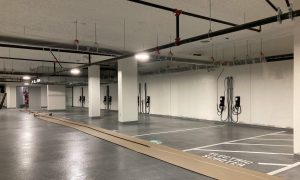The new BCIT Health Sciences Centre (HSC) is set to open in the spring of 2022. The four-storey, 111,460 square-feet building is a state-of-the-art teaching facility designed to foster learning and collaboration across all BCIT health students. This new building is also one of the most sustainable and accessible facilities on campus.
Efficient systems
Below the ground on White Avenue, there is a geo-exchange field that will transfer heat to and from the new HSC. During the summer, heat is removed from the building and stored underground in 72 wells, each 75 metres deep. Then during the winter, it is extracted to heat the building, a far more efficient heating system.
An efficient heating system redistributes heat around the building to minimize the need to generate new heat from the plant. In a typical building, rooms are cooled by removing heat and ejecting it outdoors. The HSC system is more efficient and intelligent. Areas in the building like electrical or server rooms that will need year-round cooling have their heat extracted and redistributed to other areas of the building where heat is needed.
Sustainable transportation

The new Health Sciences Centre’s underground parking space will be home to 60 Level 2 electric vehicle chargers. This will make the BCIT Burnaby Campus home to one of the largest charging centres for electric vehicles in all of Metro Vancouver. During construction, BCIT was able to divert the excavation material and relocate it on site to support the restauration of a major ecological habitat.
The building also includes bicycle storage with shower amenities to support students, faculty and staff who want to commute on a bike.
Health and wellbeing
The HSC is designed to meet the WELL Standard for construction. This certification recognizes buildings that are thoughtful and enhance human health and wellbeing.
- The building design includes elements that connect the space to the natural environment such as the four-story feature wall will picture a natural landscape including water, land and trees complemented by natural sound recording projected throughout the space.
- The building also features extensive access to natural daylight and views to nature from classrooms and social spaces.
- The building will include a rooftop garden. Materials and plants have been carefully selected to pay tribute to indigenous culture and traditional use of medicinal plants.
Ian Kerr, Director of Project Services at BCIT comments: “Sustainability is at the heart of the Health Sciences Centre design. We want to create a building that made use of the upgraded utilities systems that we have installed on campus, and that connects to the natural environment.
The ideas that are used in building the Health Sciences Centre will also guide our future developments like the Tall Timber Student Housing building, so that we can meet the Institute’s ambitious sustainability goals.”
Eleonore Leclerc, Lead Architect at Stantec comments: “This project is very special to the team at Stantec, as it embodies our own values and aspirations. Our design team is proud to have worked with BCIT in making the Health Sciences Centre a truly innovative project both from a sustainability and inclusivity perspective.”

1 thought on “How BCIT is building a sustainable home for health sciences education in BC”